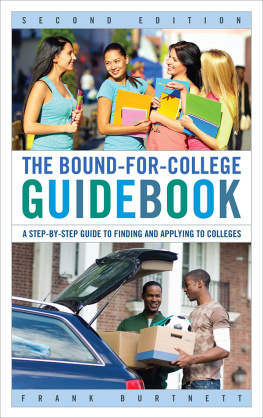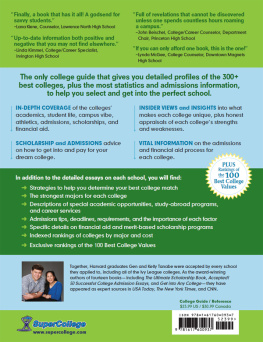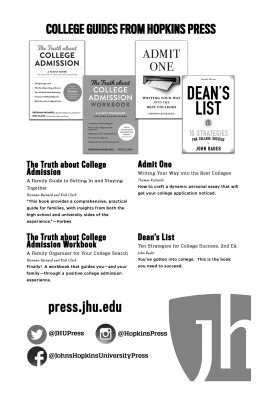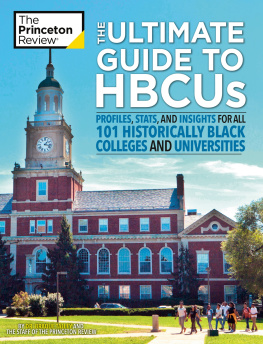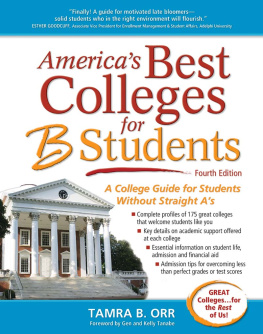Barry Beckham - The Black Students Guide to Colleges
Here you can read online Barry Beckham - The Black Students Guide to Colleges full text of the book (entire story) in english for free. Download pdf and epub, get meaning, cover and reviews about this ebook. year: 1996, publisher: Madison Books, genre: Home and family. Description of the work, (preface) as well as reviews are available. Best literature library LitArk.com created for fans of good reading and offers a wide selection of genres:
Romance novel
Science fiction
Adventure
Detective
Science
History
Home and family
Prose
Art
Politics
Computer
Non-fiction
Religion
Business
Children
Humor
Choose a favorite category and find really read worthwhile books. Enjoy immersion in the world of imagination, feel the emotions of the characters or learn something new for yourself, make an fascinating discovery.

- Book:The Black Students Guide to Colleges
- Author:
- Publisher:Madison Books
- Genre:
- Year:1996
- Rating:5 / 5
- Favourites:Add to favourites
- Your mark:
- 100
- 1
- 2
- 3
- 4
- 5
The Black Students Guide to Colleges: summary, description and annotation
We offer to read an annotation, description, summary or preface (depends on what the author of the book "The Black Students Guide to Colleges" wrote himself). If you haven't found the necessary information about the book — write in the comments, we will try to find it.
The Black Students Guide to Colleges — read online for free the complete book (whole text) full work
Below is the text of the book, divided by pages. System saving the place of the last page read, allows you to conveniently read the book "The Black Students Guide to Colleges" online for free, without having to search again every time where you left off. Put a bookmark, and you can go to the page where you finished reading at any time.
Font size:
Interval:
Bookmark:
The Black Students
Guide to Colleges
Guide to Colleges
Fourth Edition
Barry Beckham

Copyright 1997 by Barry Beckham
All rights reserved.
No part of this book may be reproduced in any form or by any electronic or mechanical means, including information storage and retrieval systems, without written permission from the publisher, except by a reviewer who may quote passages in a review.
Published by Madison Books
4720 Boston Way
Lanham, Maryland 20706
3 Henrietta Street
London WC2E 8LU, England
ISBN: 978-1-56833-080-8
Distributed by National Book Network
 The paper used in this publication meets the minimum requirements of American National Standard for Information SciencesPermanence of Paper for Printed Library Materials, ANSI Z39.481984.
The paper used in this publication meets the minimum requirements of American National Standard for Information SciencesPermanence of Paper for Printed Library Materials, ANSI Z39.481984.
Manufactured in the United States of America.
Now, fourteen years after the first edition of the guide was published, black students on predominantly white college campuses are still facing environments that foster isolation and hostility.
As students have said on countless occasions, the campus is a microcosm of the larger society. And just as there is no racial paradise in America, there is no racial paradise for students attending white colleges.
There are, of course, some collegiate environments that will offer a more comfortable experience than others. One premise of this guide is that you owe it to yourself to ask hard questions about these environments before you fill out the admission applications. Another premise is that if the colleges have not demonstrated a commitment to respecting and supporting your presence, you may do well to look elsewhere.
These profiles, therefore, focus on the what-have-you-done-for-me-lately aspects of academics, support services, black student organizations, social life and general climate. In some cases, the evidence will show that the colleges do not care about you at all. In other instances, you will find inspiring examples of campuses committed to doing their best to offer equality of opportunity.
Good luck, and remember that your primary purpose is to finish the requirements and walk.
Barry Beckham
August 1996
Silver Spring, Maryland
Applying to college is a very confusing ordeal. There are tests to take, fees to pay, recommendations to secure, forms to fill out, and deadlines to meet. The cardinal rule is to begin the process very earlyan early start will give you a competitive edge.
Begin no later than your junior year. The first thing to do is to browse through the college catalog section of your high school or local library. Try to get an understanding of the different types of colleges available and of which type best suits your needs.
Remember, colleges differ in many very important ways. Some are very large, others quite small; some urban, some rural; some extremely expensive, others relatively inexpensive. There are traditionally black colleges and predominantly white colleges; residential colleges and commuting colleges. The many advantages and disadvantages involved in each relate closely to your own personal requirements.
One starting point is to find out which colleges offer the strongest programs in your major area of interest. Then, compare the other considerations of size, location, cost, academic rating and social factors that distinguish one school from the next. It is very important to have long discussions about those colleges with your guidance counselor, your teachers and your parents.
By junior year you should have already established a good record of academic achievement. Do not slack off now. Grades from junior year on are considered most important by admission officers. This should be a year of continued achievement and standardized test taking.
In September, you should register to take the Preliminary Scholastic Aptitude Test (PSAT) which will be given in October. The PSAT is a practice test for the Scholastic Aptitude Test (SAT) which will be given in May. Both tests are important, because it is primarily on the basis of your high school grades and these test scores that colleges decide whether or not to offer you admission.
Both exams test verbal and mathematical skills. The best way to prepare for them outside of a formal test-taking course is to read very widely, review your basic math skills and study carefully the practice test and information bulletin which come with your registration materials.
All of these tests require you to pay certain fees. If you do not have the money to pay for the tests, ask your guidance counselor about fee waivers.
During the summer before senior year you should continue to investigate your different college choices. This is a good time to write away for up-to-date college catalogs, handbooks, and application forms. Study these materials carefully so that you will understand what you will need to do in September to make the application process flow smoothly.
Most important, see what the average SAT score and high school grade-point averages are for students admitted to the schools you are interested in. If your SAT scores and grade-point average are not as high as they should be, dont despair. You will still have time to get better grades first semester senior year, and better SAT scores the following December.
The process of applying to college really gains momentum during the fall semester of your senior year. Write to colleges for any additional admission and financial aid materials. Spend more time talking with your guidance counselor about the different colleges, and ask if there are any additional tests you must take or scholarship programs you can apply to. Find out the earliest date that your parents can file a Free Application for Federal Student Aid (FAFSA). The FAFSA is a questionnaire which is used to determine your financial needs. If you file it early, you will have enough time to correct mistakes and discrepancies.
In September, you should approach teachers who know you well and ask them if they would be willing to write you a recommendation to college. Check back with them to see if they have mailed the forms.
Then begin to think about what you are going to say in the personal essay which many colleges require. Carefully construct a draft of your essay, including all of your achievements and extracurricular activities. After you have written the first draft, show it to some of your English teachers to get their critical response. Rewrite your essay on the basis of those responses, and then put it away until you finish the rest of your application.
Remember to register for the December SAT and the College Board Achievement Test which will be given in January. Make sure that all of the colleges that you are applying to are receiving copies of your high school transcripts, your SAT scores, your FAFSA reports and your teacher recommendations.
Be sure to apply to at least one school where your grade point average and SAT scores are above that of most students who were accepted the previous year. This school will be your safety school or school to which you are more than likely to gain admission. Then try to apply to at least one school where your grades and scores are slightly below those of previously admitted applicants. This school might be a long shot, but it is always possible that you can build a strong case for yourself.
Next pageFont size:
Interval:
Bookmark:
Similar books «The Black Students Guide to Colleges»
Look at similar books to The Black Students Guide to Colleges. We have selected literature similar in name and meaning in the hope of providing readers with more options to find new, interesting, not yet read works.
Discussion, reviews of the book The Black Students Guide to Colleges and just readers' own opinions. Leave your comments, write what you think about the work, its meaning or the main characters. Specify what exactly you liked and what you didn't like, and why you think so.

